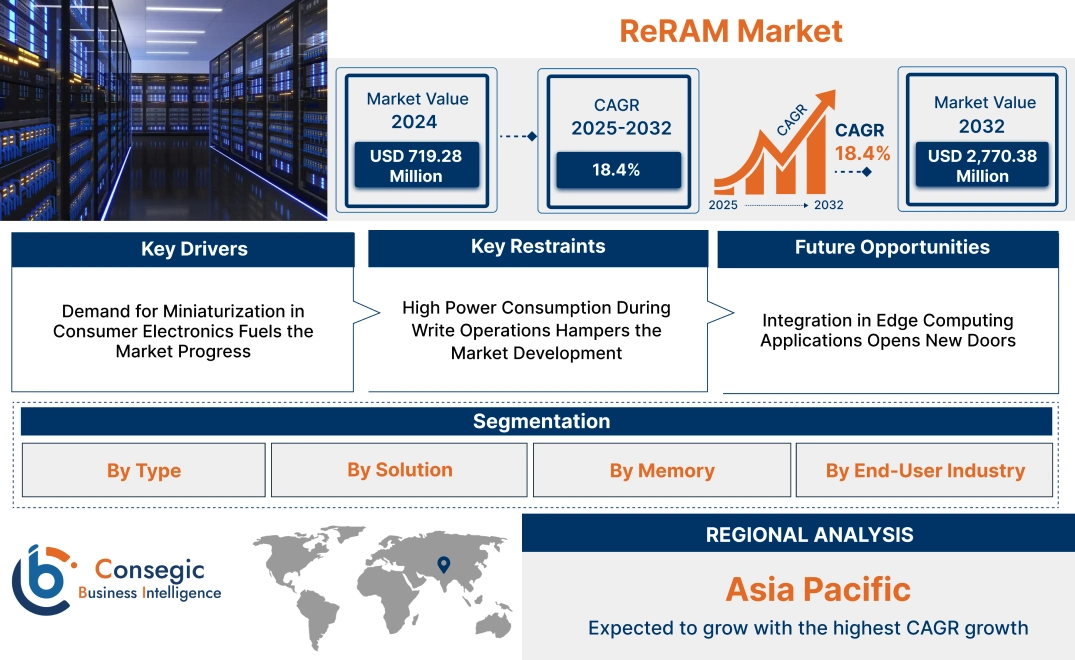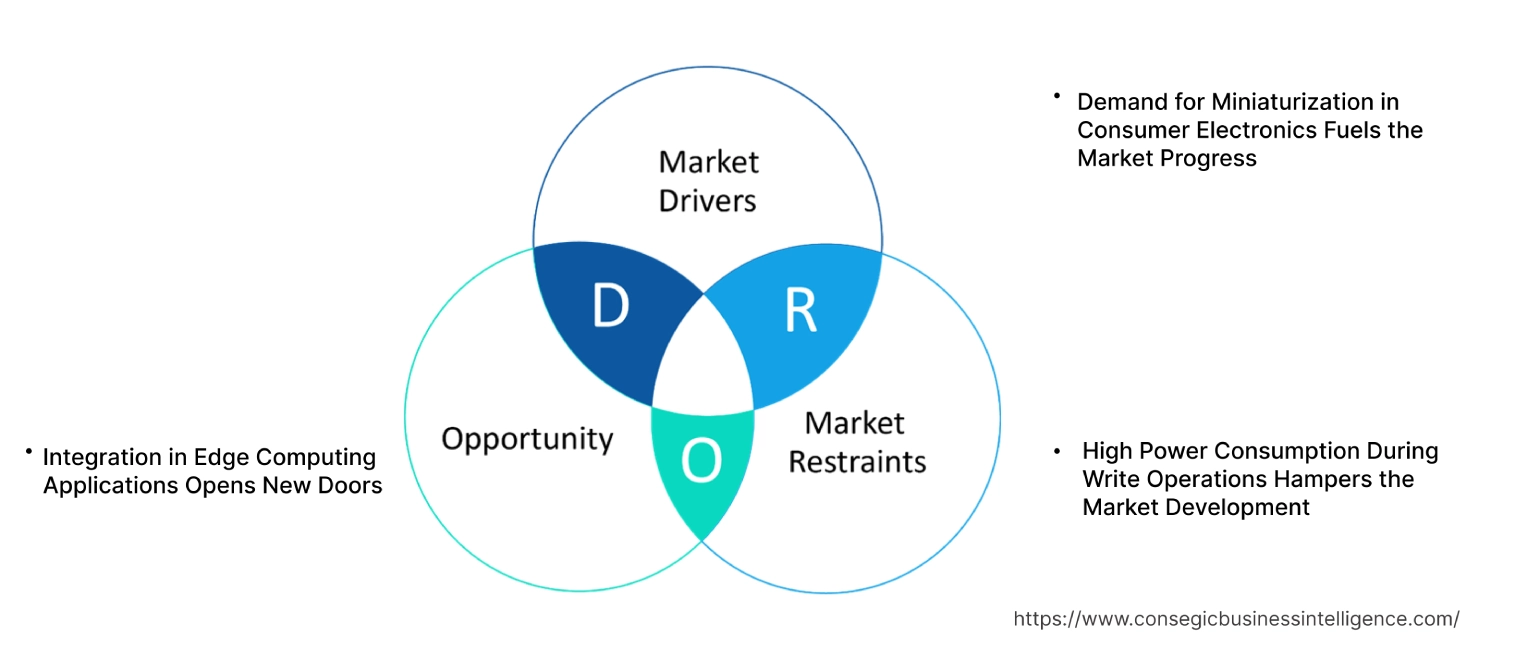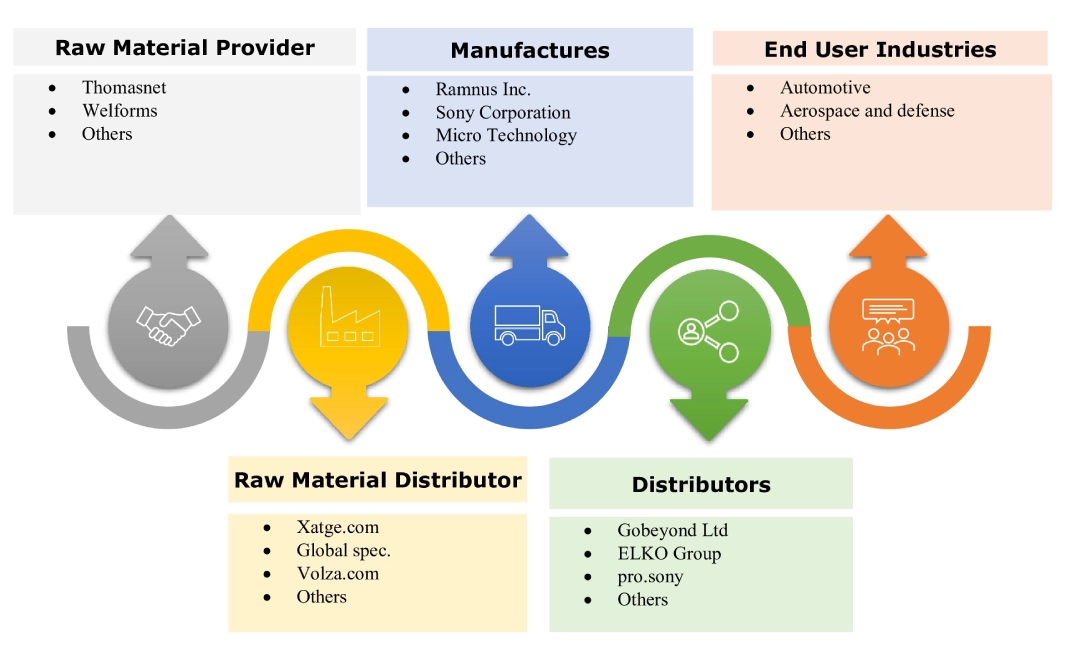- Summary
- Table Of Content
- Methodology
ReRAM Market Size:
ReRAM Market size is estimated to reach over USD 2,350.41 Million by 2031 from a value of USD 617.39 Million in 2023 and is projected to grow by USD 718.68 Million in 2024, growing at a CAGR of 18.2% from 2024 to 2031.
ReRAM Market Scope & Overview:
ReRAM stands for Resistive Random Access Memory. It is a non-volatile memory, thus ReRAM memory can retain stored data even after power is disconnected. ReRAM stores data by transferring the resistance of a material between two electrodes. ReRAM stores data in digital format or 0's and 1's. ReRAM gives strong competition to other non-volatile memory technologies to become next-generation storage and memory technologies shortly. ReRAM consumes less power than NAND and has faster writing and reading speeds, it has high storage capacity. ReRAM has better switching speed and retention. ReRAM stores data in the flexible conversion of the resistance phase controlled by the electronic pulse. ReRAM is utilized in the production of multistate memory, working for information processing, sensors, and neuro networks. It is used in multifunction systems with wider applications. ReRAM is optimized in applications such as analog and power ICs, automotive, storage class memory (SCM), IoT devices, aerospace and defense, edge AI processing, medical devices, and others.
ReRAM Market Insights:
Key Drivers:
Demand for Faster and Energy-Efficient Memory is Fueling the Market
The demand for faster and more energy-efficient memory is growing rapidly due to the increasing data processing needs in fields such as AI, cloud computing, IoT, and others. One of the key drivers of ReRAM is the growing need for faster and more energy-efficient memory solutions in devices such as smartphones, laptops, and servers. Traditional memory systems face limitations in speed and power efficiency, creating hurdles in performance. Innovations in ReRAM memory and materials are addressing these challenges. The data-hefty applications such as AI, IoT, and cloud computing require memory that operates with low power consumption and faster processing speeds. ReRAM memory type can switch between resistance states to store data, reducing the energy required for data transmission between storage and processing units.
- In June 2024, NuMicro M2L31 microcontroller from Nuvoton, built on the arm cortex-M23 core, is available in several configurations offering 64 to 512 Kbytes of ReRAM and 40 to 168 Kbytes of SRAM. M2L31 stands out in consumption of low power, and its running speed is up to 72MHz providing great processing capability.
The above innovations are crucial in meeting the demands of modern applications, such as AI and data-centric computing, which require memory solutions that can handle vast amounts of data efficiently, thereby, driving the ReRAM market growth.
Rising Adoption of Wearable Devices Spurs the Market
Wearable devices demand high-performance, low-power memory solutions. They require memory solutions that consume minimal power to extend battery life. ReRAM, known for its speed, energy efficiency, and ability to store large amounts of data in compact spaces, is emerging as a crucial technology for wearables such as smartwatches, fitness trackers, and medical devices.
- In March 2022, Fujitsu Semiconductor, introduced a 12Mbit ReRAM, which boasts the highest memory density in its product line. This non-volatile memory is particularly suited for small, battery-operated devices including hearing aids and smartwatches due to its compact size (approximately 2mm x 3mm) and low power consumption, with an average read current of only 0.15mA.
Thus, the wearable devices such as hearing aids and smartwatches market have been expanding rapidly, which directly correlates with the rising ReRAM market demand.
Key Restraints :
Competition from Other Emerging Memory Technologies Limits the Market
ReRAM faces significant competition from other developing non-volatile memory technologies such as PCRAM (Phase-Change RAM), MRAM (Magnetoresistive RAM), and FRAM (Ferroelectric RAM). Each of these technologies offers unique benefits, making the competition tough in the mass market. MRAM excels in endurance and speed, and PCRAM offers higher data density and scalability compared to ReRAM, but it tends to consume more power during writing operations. Companies continue to improve FRAM's performance in automotive and industrial applications, where quick data retrieval and low power consumption are critical.
- For July 2024, Avalanche Technologies announced advancements in MRAM technology, for aerospace and defense, focusing on high-density applications such as AI and machine learning, which directly competes with ReRAM's in similar areas.
Therefore, the prevalence of several other substitutes for ReRAM is restraining the ReRAM market growth.
Future Opportunities :
Rising Technologies such as IoT and Edge Computing Opens New Doors
The rapid expansion of Internet of Things (IoT) devices, and edge computing is creating significant opportunities for advanced memory technologies like ReRAM. As IoT networks continue to grow, there is an increasing need for faster, energy-efficient, and durable memory solutions. ReRAM meets this demand due to its low power consumption, faster data access quality, and ability to retain data without continuous power supply, which are crucial for devices that rely on battery life, such as wearables, sensors, and industrial monitoring systems. Edge computing requires memory solutions that can handle real-time data processing in smaller and distributed computing systems. ReRAM's scalability and speed make it suitable for such applications, specifically as edge devices need compact memory with high performance to process and store critical data, without relying on centralized cloud servers.
- In August 2024, Weebit Nano launched their Weebit ReRAM, a non-volatile memory (NVM) that eventually replaced flash memory, and provides higher performance and better security, The ReRAM was designed for several applications including IoT and edge computing among others.
Hence, the accelerating deployment of energy-efficient memory like ReRAM in devices such as IoT and edge computing, in turn, promotes ReRAM market opportunities during the forecast period.
Adoption of ReRAM in the Automotive and Aerospace Sectors to Promote Potential Opportunities
ReRAM's non-volatile nature, resistance to radiation, and low power usage are critical for space missions, where memory systems need to be highly reliable, long-term, and energy-efficient. Modern commercial and military aircraft rely on promising onboard systems for navigation, communication, and safety. The rapid development of autonomous driving technologies and ADAS has increased the need for fast, reliable memory systems. These systems demand high-end memory solutions, capable of handling massive amounts of data in real-time while operating in harsh conditions. ReRAM's ability to provide faster access times, and withstand frequent read and write cycles gives it a competitive advantage.
- In March 2023 Weebit Nano, an advanced memory technology-producing company, released their new ReRAM technology S130. It consumes ultra-low power, is radiation tolerant, and protects non-volatile memory. This can be utilized by companies for developing integrated SoCs for applications such as IoT, automotive, aerospace, industrial, and medical.
Thus, the adoption of ReRAM in the automotive and aerospace industries is projected to promote ReRAM market growth opportunities in upcoming years.
ReRAM Market Segmental Analysis :
By Type:
Based on type, ReRAM the market is segmented into Oxide-based ReRAM, Conductive Bridging RAM (CBRAM), and others.
Trends in the Type:
- There is an increasing demand for integrated oxide-based ReRAM into processors and system-on-chips for IoT and edge computing.
- Use of flexible and wearable electronics is leading CBRAM market demand.
The oxide-based ReRAM accounted for the largest revenue share of 58.22% of the total ReRAM market share in the year 2023.
- Oxide-based Resistive Random Access Memory (ReRAM), is a type of non-volatile memory that allows metal oxides to store data by changing the resistance of a material.
- The Oxide-based ReRAM uses a switching mechanism that involves the migration of oxygen vacancies or metal ions within the oxide layer.
- The Oxide-based ReRAM works on enhancing the performance of smartphones, tablets, and laptops, in turn providing reliable memory solutions for autonomous driving systems and EVs.
- In March 2022, Fujitsu Memory Solution launched their 12Mbit oxide-based ReRAM, the highest memory density in the ReRAM market. This NVM chip can store character data equivalent to around 90 pages of newspaper all within a compact package.
- Thus, as per analysis, with ongoing innovations and growing demand, oxide-based ReRAM is driving the ReRAM market demand.
The Conductive Bridging RAM (CBRAM) is anticipated to register the fastest CAGR during the forecast period.
- Conductive Bridge RAM (CBRAM), is a type of ReRAM that uses a solid electrolyte and forms a conductive metal filament between electrodes to change resistance states.
- CBRAM has attracted significant attention because of its non-volatile properties and rapid switching speeds, making it a strong contender to replace current leading memory technologies like Flash.
- CBRAM has attracted significant attention because of its non-volatile properties and rapid switching speeds, making it a strong contender to replace current leading memory technologies like Flash.
- In February 2023, GlobalFoundries announced the acquisition of Renesas Technology Company, which provides Conductive Bridging Random Access Memory (CBRAM) technology. The aim of the acquisition is to offer CBRAM as an embedded NVM option on its 22FDX silicon-on-insulator 22nm manufacturing process in 2022. Providing low power memory consumption, that facilitates applications in industrial IoT, home, and smartphone devices.
- Therefore the increasing development related to CBRAM is anticipated to boost the ReRAM market trends during the forecast period.
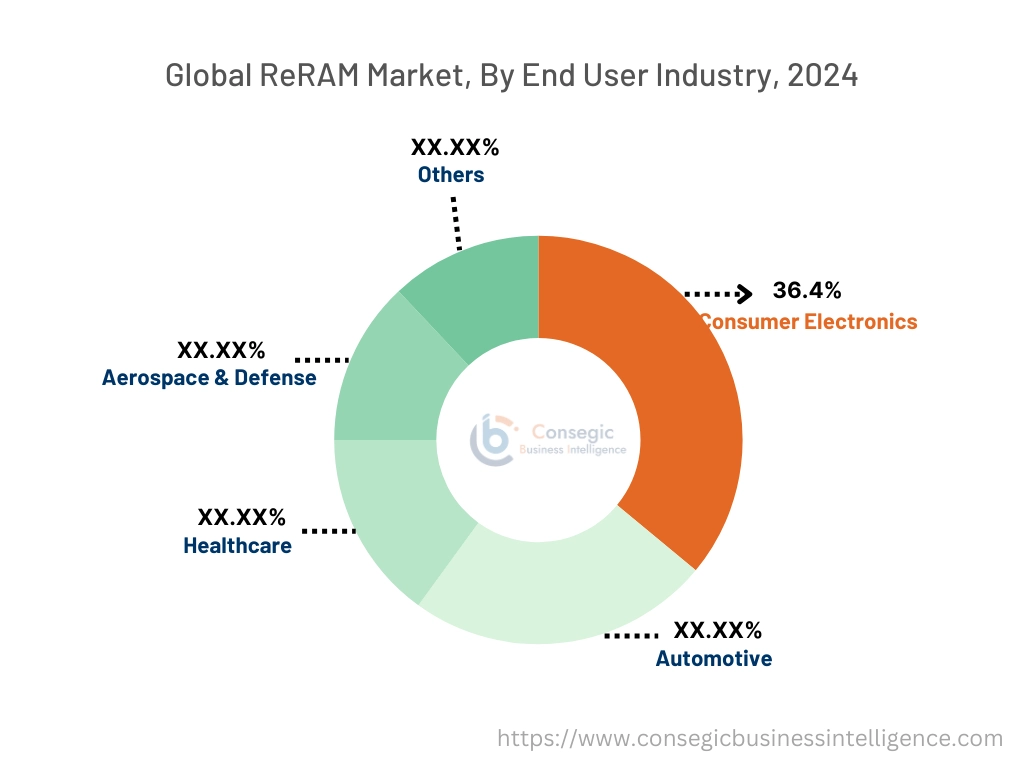
By Application :
Based on application, the market is segmented into embedded memory, stand-alone memory, neuromorphic computing, edge AI processing, and others.
Trends in the Application:
- The growing medical, transport, and industrial sectors rely majorly on embedded systems for their operations.
- Portable storage solutions in the consumer electronics, automotive, and industrial sectors are increasing the demand for ReRAM.
The embedded memory accounted for the largest revenue share of the overall ReRAM market share in the year 2023.
- ReRAM can be embedded into systems such as microcontrollers, system-on-chips (SoCs), and processors to boost performance, particularly in IoT and consumer electronics.
- Embedded memory allows processors of devices to provide their highest capacity and lower failure risk. Embedded memory can be volatile and non-volatile in nature, embedded memory is operated by an embedded operating system.
- In February 2024, KIOXIA flash memory company of Japan, released its first embedded flash memory, UFS 4.0 for the automotive sector. This embedded memory provided a vehicle communication system and high-performance memory.
- Thus, as per the analysis, the increasing advancements associated with embedded memory are driving the embedded ReRAM memory market expansion.
The stand-alone memory is anticipated to register the fastest CAGR during the forecast period.
- Stand-alone memory are memory storage devices that work independently of a computer or other local device. Typically, it is used to store and recover data, such as images, videos, notes, and other data.
- Stand-alone memory provides users with an appropriate and portable method to store and retrieve their data without the necessity for a computer or other device.
- The stand-alone memory standards are rising in the automotive sector, with a rise in self-driving cars and advanced driving assistance system integration among others. The development in the automotive sector has increased the implementation of high-performance memory that supports the market's growth.
- In February 2024, Samsungtested its first 256GB SD microSD card, providing a faster time than the present interface. Samsung has given effective solutions to achieve the growing demand for mobile computing and on-device AI.
- Therefore, the rising use of stand-alone memory for portable storage is anticipated to boost the ReRAM market trends during the forecast period.
By End-use:
Based on end use, the market for ReRAM is segmented into consumer electronics, automotive, storage class memory (SCM), IoT devices, aerospace, medical devices, and others.
Trends in the End-use:
- Innovations in material science and manufacturing processes are enhancing the performance and scalability of ReRAM.
- The consumer electronics segment is a major driver of ReRAM market growth.
- The automotive industry's push towards smart and autonomous vehicles is increasing the demand for reliable and high-performance memory solutions.
The consumer electronics segment accounted for the largest revenue share in the year 2023.
- In consumer electronics, ReRAM is increasingly integrated for superior performance characteristics.
- This technology is particularly valued for its high speed, low power consumption, and durability, which make it well-suited to the demanding requirements of modern consumer electronic devices.
- Consumer electronics manufacturers seek to integrate cutting-edge memory technology into their products. ReRAM is increasingly being integrated into smartphones, tablets, laptops, wearables, and other consumer devices.
- For instance, in September 2024, OnePlus mobile, a major smartphone manufacturer, revealed that its latest flagship model will feature ReRAM, to boost performance and battery life. This move highlights the growing importance of ReRAM in delivering cutting-edge consumer electronics.
- Thus, as the technology continues to evolve, ReRAM is expected to play a crucial role in shaping the future of consumer electronics, offering enhanced performance and better user experiences, in turn driving the ReRAM market growth.
The automotive segment is anticipated to register the fastest CAGR during the forecast period.
- The automotive industry increasingly demands advanced memory solutions to support the growing complexity of electronic systems and the push toward autonomous driving technologies.
- The automotive industry's flow towards smart and autonomous vehicles is increasing the demand for reliable and high-performance memory solutions. ReRAM's high endurance and stability make it ideal for utilization in the automotive sector. It consumes less power than traditional memory technologies.
- In February 2024, Weebit Nano's ReRAM demonstrates exceptional reliability and endurance under extended automotive conditions, operating effectively at extreme temperatures up to 150°C. It boasts a lifetime operation with impressive cycling and retention capabilities, along with a 100,000-cycle endurance. Weebit Nano ReRAM is ideal for automotive applications, they offer advantages such as ease of integration, cost-efficiency, power efficiency, and radiation tolerance.
- Therefore, the rising automotive sector is anticipated to boost the ReRAM market expansion during the forecast period.
Regional Analysis:
The regions covered are North America, Europe, Asia Pacific, the Middle East and Africa, and Latin America.
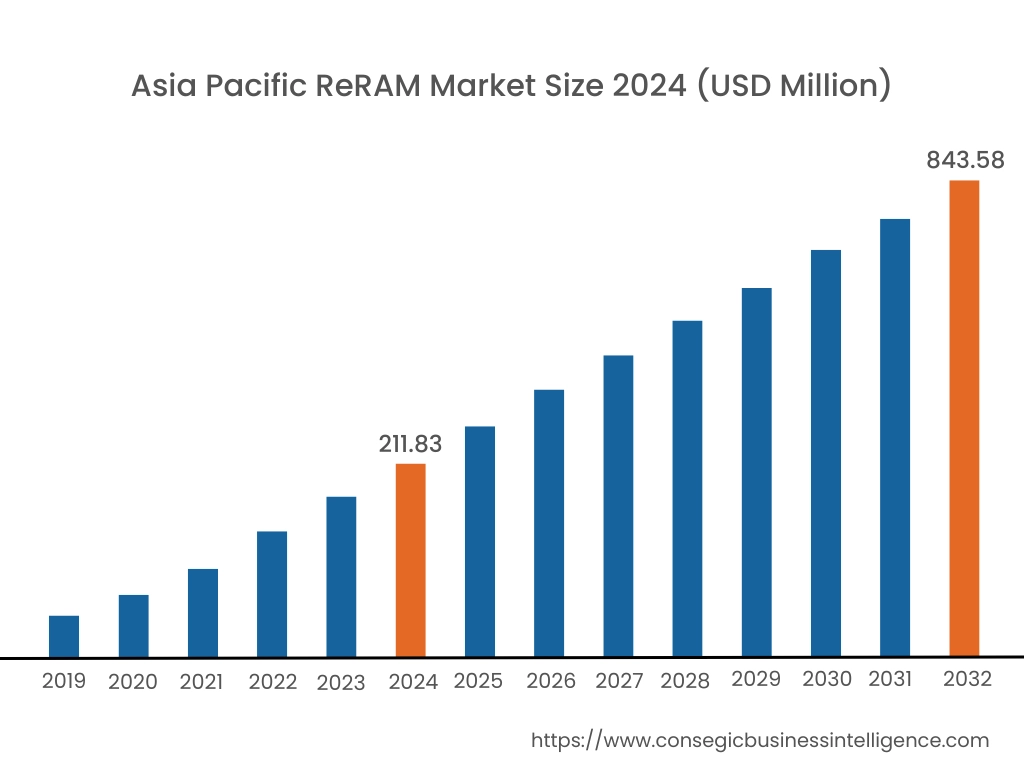
Asia Pacific region was valued at USD 212.17 Million in 2023. Out of this, China accounted for the maximum revenue share of 34.8%. Moreover, it is projected to grow by USD 247.53 Million in 2024 and reach over USD 829.70 Million by 2031. As per the ReRAM market analysis, the Asia-Pacific region, including China, Japan, South Korea, and India, is the fastest-growing market for ReRAM. The region benefits from rapid technological advancements, a large consumer electronics manufacturing base, and increasing investments in IoT and AI.
- In September 2024, China achieved two significant milestones in the semiconductor chip industry it successfully mass-produced the world's first 28nm embedded RRAM image quality adjustment chip and developed the world's first 16-bit quantum bit semiconductor microprocessor chip.
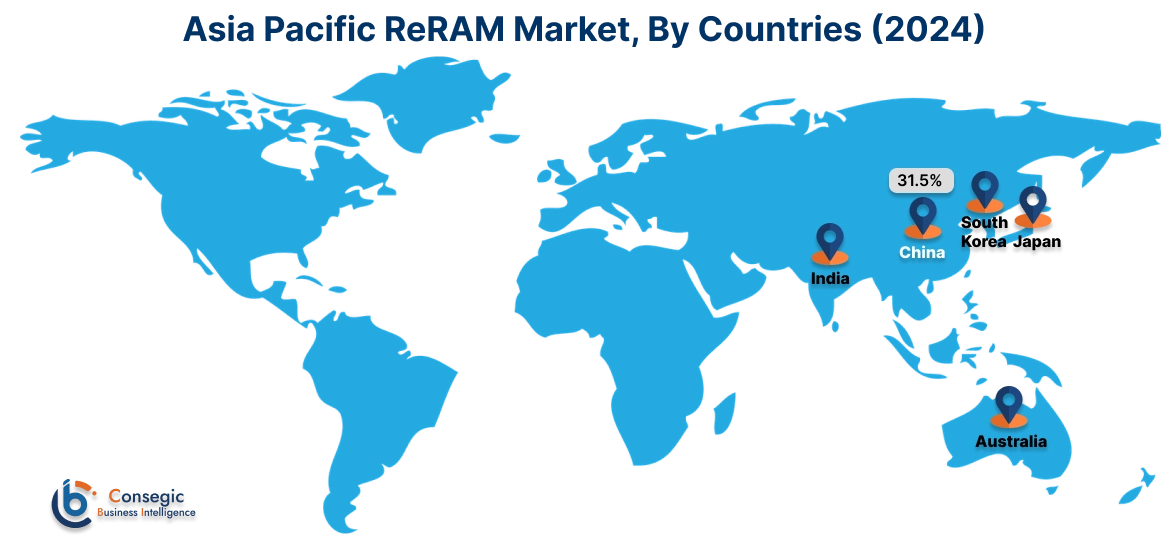
North America is estimated to reach over USD 738.03 Million by 2031 from a value of USD 191.09 Million in 2023 and is projected to grow by USD 222.71 Million in 2024. North America, particularly the United States and Canada, is a key player in the global ReRAM (Resistive Random Access Memory) market. The region's leadership in technology innovation, high investment in research and development, and robust consumer electronics industry contribute to its dominant position in the ReRAM sector. Additionally, North American data centers are increasingly incorporating ReRAM to enhance performance and efficiency.
- In April 2022, CrossBar a U.S.-based company manufacturer of non-volatile memory, launched its new application of ReRAM technology for secure storage and data handling. There Resistive RAM (ReRAM) technology is utilized in secure storage and processing systems, where it is crucial to ensure resistance against reverse engineering and physical attacks.
Thus, the need for high-speed, reliable memory solutions, and data security in consumer electronics, data centers, and other applications is driving the adoption of ReRAM.
Europe is a significant player in the global ReRAM market, with increasing adoption driven by advancements in automotive technology, industrial automation, and consumer electronics. The region's focus on innovation and its strong industrial base contribute to the growing demand for ReRAM solutions.
- In June 2024, Taiwan semiconductor manufacturing company (TSMC) planned its first European semiconductor plant, known as Fab 24. The joint venture European Semiconductor Manufacturer Company (ESMC) was formed between manufacturers Bosch, Infineon and NXP, TSMC for operation and construction of the plant. ESMC also focuses on the production of ReRAM and MRAM non-volatile memory chips.
Latin America is an emerging market for ReRAM, with slower but steady growth. The region is beginning to adopt advanced memory technologies as the demand for consumer electronics and technology infrastructure grows.
The Middle East and Africa represent a smaller segment of the ReRAM market but are experiencing growth due to investments in technology and infrastructure development. The region's focus on modernizing technology and increasing digital infrastructure is contributing to the gradual adoption of ReRAM.
Top Key Players & Market Share Insights:
The ReRAM market is highly competitive with major players providing memory solutions to the national and international markets. Key players are adopting several strategies in research and development (R&D), product innovation, and end-user launches to hold a strong position in the global ReRAM market. Key players in the ReRAM industry include-
- Fujitsu Limited (Japan)
- Crossbar Inc. (US)
- Weebit Nano (Israel)
- 4DS Memory (Australia)
- Intel Corporation (US)
- SK Hynix Inc. (South Korea)
- Panasonic Corporation (Japan)
- Adesto Technologies Corporation (US)
- Micron Technology, Inc. (US)
- Rambus Inc. (US)
- Sony Corporation (Japan)
Recent Industry Developments :
Product Launches:
- In May 2024,Memory Limited, launched their new form of ReRAM technology for AI processing, providing high-bandwidth, high-endurance determined memory for big data and neural net applications.
- In July 2024,Nuvoton Technology Corp, a semiconductor company, launched their M2L31Cortex-M23 microcontroller range with embedded ReRAM. This range embraces battery management, industrial mechanization, and consumer devices.
- In May 20244DS technology, announced their new switching ReRAM technology optimized in AI processing, bringing high bandwidth, high resistance, and endurance ideal for big data and neuromorphic computing technology.
Investments:
- In April 2024, ByteDance Ltd., the Beijing-based company that owns the popular video-sharing platform TikTok, invested in InnoStar semiconductor, a Shanghai-based startup focused on the development of ReRAM technology.
ReRAM Market Report Insights :
| Report Attributes | Report Details |
| Study Timeline | 2018-2031 |
| Market Size in 2031 | USD 2,350.41 Million |
| CAGR (2024-2031) | 18.2% |
| By Type |
|
| By Application |
|
| By End-Use |
|
| By Region |
|
| Key Players |
|
| North America | U.S. Canada Mexico |
| Europe | U.K. Germany France Spain Italy Russia Benelux Rest of Europe |
| APAC | China South Korea Japan India Australia ASEAN Rest of Asia-Pacific |
| Middle East and Africa | GCC Turkey South Africa Rest of MEA |
| LATAM | Brazil Argentina Chile Rest of LATAM |
| Report Coverage |
|
Key Questions Answered in the Report
How big is the ReRAM market? +
ReRAM Market size is estimated to reach over USD 2,350.41 Million by 2031 from a value of USD 617.39 Million in 2023 and is projected to grow by USD 718.68 Million in 2024, growing at a CAGR of 18.2% from 2024 to 2031.
Which is the fastest-growing region in the ReRAM market? +
Asia Pacific is the region experiencing the most rapid growth in the ReRAM market.
What specific segmentation details are covered in the ReRAM report? +
The ReRAM report includes specific segmentation details for type, application, end-user, and region.
Who are the major players in the ReRAM market? +
Fujitsu Limited (Japan), Crossbar Inc. (US), Weebit Nano (Israel), 4DS Memory (Australia), Intel Corporation (US), SK Hynix Inc. (South Korea), Panasonic Corporation (Japan), Adesto Technologies Corporation (US), Micron Technology, Inc., Rambus Inc. (US), Sony Corporation (Japan).
